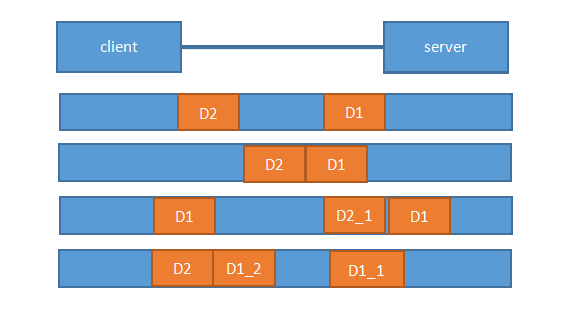NETTY通讯协议

按行分割协议
LineBasedFrameDecoder和LineEncoder采用的通信协议非常简单,即按照行进行分割,遇到一个换行符,则认为是一个完整的报文。在发送方,使用LineEncoder为数据添加换行符;在接受方,使用LineBasedFrameDecoder对换行符进行解码。
LineBasedFrameDecoder
LineBasedFrameDecoder采用的通信协议格式非常简单:使用换行符\n或者\r\n作为依据,遇到\n或者\r\n都认为是一条完整的消息。
LineBasedFrameDecoder提供了2个构造方法,如下:
1 | public LineBasedFrameDecoder(final int maxLength) { |
参数
maxLength
表示一行最大的长度,如果超过这个长度依然没有检测到\n或者\r\n,将会抛出TooLongFrameException
failFast
与maxLength联合使用,表示超过maxLength后,抛出TooLongFrameException的时机。如果为true,则超出maxLength后立即抛出TooLongFrameException,不继续进行解码;如果为false,则等到完整的消息被解码后,再抛出TooLongFrameException异常。
stripDelimiter
解码后的消息是否去除\n,\r\n分隔符,例如对于以下二进制字节流:
1 | +--------------+ |
如果stripDelimiter为true,则解码后的结果为:
1 | +-----+-----+ |
如果stripDelimiter为false,则解码后的结果为:
1 | +-------+---------+ |
LineEncoder
按行编码,给定一个CharSequence(如String),在其之后添加换行符\n或者\r\n,并封装到ByteBuf进行输出,与LineBasedFrameDecoder相对应。LineEncoder提供了多个构造方法,最终调用的都是:
1 | public LineEncoder(LineSeparator lineSeparator, //换行符号 |
Netty提供了LineSeparator来指定换行符,其定义了3个常量, 一般使用DEFAULT即可。
1 | public final class LineSeparator { |
使用案例
LineBasedFrameDecoder / LineEncoder使用案例
服务端
1 | public class LineBasedFrameDecoderServer { |
LineBasedFrameDecoder要解决粘包问题,根据”\n”或”\r\n”对二进制数据进行解码,可能会解析出多个完整的请求报文,其会将每个有效报文封装在不同的ByteBuf实例中,然后针对每个ByteBuf实例都会调用一次其他的ChannelInboundHandler的channelRead方法。
因此LineBasedFrameDecoder接受到一次数据,其之后的ChannelInboundHandler的channelRead方法可能会被调用多次,且之后的ChannelInboundHandler的channelRead方法接受到的ByteBuf实例参数,包含的都是都是一个完整报文的二进制数据。因此无需再处理粘包问题,只需要将ByteBuf中包含的请求信息解析出来即可,然后进行相应的处理。本例中,我们仅仅是打印。
客户端
1 | public class LineBasedFrameDecoderClient { |
需要注意的是,在client端,我们并没有使用LineEncoder进行编码,原因在于我们要模拟粘包、拆包。如果使用LineEncoder,那么每次调用ctx.write或者ctx.writeAndflush,LineEncoder都会自动添加换行符,无法模拟拆包问题。
我们通过自定义了一个ChannelInboundHandler,用于在连接建立后,发送3个请求报文req1、req2、req3。其中req1和req2都是一个完整的报文,因为二者都包含一个换行符;req3分两次发送,第一次发送req3_1,第二次发送req3_2。
首先我们将req1、req2和req3_1一起发送:
1 | +------------------------+ |
而服务端经过解码后,得到两个完整的请求req1、req2、以及req3的部分数据:
1 | +----------+----------+-------- |
由于req1、req2都是一个完整的请求,因此可以直接处理。而req3由于只接收到了一部分(半包),需要等到2秒后,接收到另一部分才能处理。
因此当我们先后启动server端和client之后,在server端的控制台将会有类似以下输出:
1 | LineBasedFrameDecoderServer Started on 8080... |
可以看到hello1和hello2是同一时间打印出来的,而hello3是2秒之后才打印。说明LineBasedFrameDecoder成功帮我们处理了粘包和半包问题。
小结
- 部分同学可能认为调用一个writeAndFlush方法就是发送了一个请求,这是对协议的理解不够深刻。一个完整的请求是由协议规定的,例如我们在这里使用了LineBasedFrameDecoder,潜在的含义就是:一行数据才算一个完整的报文。因此当你调用writeAndFlush方法,如果发送的数据有多个换行符,意味着相当于发送了多次有效请求;而如果发送的数据不包含换行符,意味着你的数据还不足以构成一个有效请求。
- 对于粘包问题,例如是两个有效报文粘在一起,那么服务端解码后,可以立即处理这两个报文。
- 对于拆包问题,例如一个报文是完整的,另一个只是半包,netty会对半包的数据进行缓存,等到可以构成一个完整的有效报文后,才会进行处理。这意味着么netty需要缓存每个client的半包数据,如果很多client都发送半包,缓存的数据就会占用大量内存空间。因此我们在实际开发中,不要像上面案例那样,有意将报文拆开来发送。
- 此外,如果client发送了半包,而剩余部分内容没有发送就关闭了,对于这种情况,netty服务端在销毁连接时,会自动清空之前缓存的数据,不会一直缓存。
分隔符与Base64编解码
DelimiterBasedFrameDecoder
上一节我们介绍了LineBasedFrameDecoder,其以换行符\n或者\r\n作为依据,遇到\n或者\r\n都认为是一条完整的消息。
而DelimiterBasedFrameDecoder与LineBasedFrameDecoder类似,只不过更加通用,允许我们指定任意特殊字符作为分隔符。我们还可以同时指定多个分隔符,如果在请求中发的确有多个分隔符,将会选择内容最短的一个分隔符作为依据。
例如:
1 | +--------------+ |
如果我们指定分隔符为\n,那么将会解码出来2个消息
1 | +-----+-----+ |
如果我们指定\r\n作为分隔符,那么只会解码出来一条消息
1 | +----------+ |
DelimiterBasedFrameDecoder提供了多个构造方法,最终调用的都是以下构造方法:
1 | public DelimiterBasedFrameDecoder( |
参数
maxLength
表示一行最大的长度,如果超过这个长度依然没有检测到\n或者\r\n,将会抛出TooLongFrameException
failFast
与maxLength联合使用,表示超过maxLength后,抛出TooLongFrameException的时机。如果为true,则超出maxLength后立即抛出TooLongFrameException,不继续进行解码;如果为false,则等到完整的消息被解码后,再抛出TooLongFrameException异常。
stripDelimiter
解码后的消息是否去除分隔符。
delimiters
分隔符,我们需要先将分割符,写入到ByteBuf中,然后当做参数传入。
需要注意的是,netty并没有提供一个DelimiterBasedFrameDecoder对应的编码器实现(笔者没有找到),因此在发送端需要自行编码,添加分隔符。
Base64编解码
对于以特殊字符作为报文分割条件的协议的解码器,如:LineBasedFrameDecoder、DelimiterBasedFrameDecoder。都存在一个典型的问题,如果发送数据当中本身就包含了分隔符,怎么办?如:我们要发送的内容为:
1 | hello1\nhello2\nhello3\n |
我们需要把这个内容整体当做一个有效报文来处理,而不是拆分成hello1、hello2、hello3。一些同学可能想到那可以换其他的特殊字符,但是如果内容中又包含你想指定的其他特殊字符怎么办呢?
因此我们通常需要发送的内容进行base64编码,base64中总共只包含了64个字符。
| 索引 | 对应字符 | 索引 | 对应字符 | 索引 | 对应字符 | 索引 | 对应字符 |
|---|---|---|---|---|---|---|---|
| 0 | A | 17 | R | 34 | i | 51 | z |
| 1 | B | 18 | S | 35 | j | 52 | 0 |
| 2 | C | 19 | T | 36 | k | 53 | 1 |
| 3 | D | 20 | U | 37 | l | 54 | 2 |
| 4 | E | 21 | V | 38 | m | 55 | 3 |
| 5 | F | 22 | W | 39 | n | 56 | 4 |
| 6 | G | 23 | X | 40 | o | 57 | 5 |
| 7 | H | 24 | Y | 41 | p | 58 | 6 |
| 8 | I | 25 | Z | 42 | q | 59 | 7 |
| 9 | J | 26 | a | 43 | r | 60 | 8 |
| 10 | K | 27 | b | 44 | s | 61 | 9 |
| 11 | L | 28 | c | 45 | t | 62 | + |
| 12 | M | 29 | d | 46 | u | 63 | / |
| 13 | N | 30 | e | 47 | v | ||
| 14 | O | 31 | f | 48 | w | ||
| 15 | P | 32 | g | 49 | x | ||
| 16 | Q | 33 | h | 50 | y |
我们可以指定这64个字符之外的其他字符作为特殊分割字符;而接收端对应的进行base64解码,得到对应的原始的二进制流,然后进行处理。Netty提供了Base64Encoder/Base64Decoder来帮我们处理这个问题。需要注意的是,只需要对内容进行base64编码,分隔符不需要编码。
使用案例
DelimiterBasedFrameDecoder结合Base64编解码案例
服务端
1 | public class DelimiterBasedFrameDecoderServer { |
Server接受到的数据,首先我们要去除分隔符,然后才能进行base64解码。因此首选我们添加了DelimiterBasedFrameDecoder根据&处理粘包办包问题,之后使用Base64Decoder进行解码,最后通过一个自定义ChannelInboundHandler打印请求的数据。
客户端
1 | public class DelimiterBasedFrameDecoderClient { |
在编写client端代码时我们先对原始内容进行base64编码,然后添加分割符之后进行输出。
需要注意,虽然Netty提供了Base64Encoder进行编码,这里并没有直接使用,如果直接使用Base64Encoder,那么会对我们输出的所有内容进行编码,意味着分隔符也会被编码,这显然不符合我们的预期,所以这里直接使用了Netty提供了Base64工具类来处理。
如果一定要使用Base64Encoder,那么代码需要进行相应的修改,自定义的ChannelInboundHandler只输出原始内容,之后通过Base64Encoder进行编码,然后需要额外再定义一个ChannelOutboundHandler添加分隔符,如:
1 | ch.pipeline().addLast(new ChannelOutboundHandlerAdapter() { |
上述两种方案效果是等价的。
当我们先后启动server和client后,会看到server端控制台输出:
1 | DelimiterBasedFrameDecoderServer Started on 8080... |
说明经过base64编码后,我们的请求中可以包含分隔符作为内容。
如果我们将base64编解码相关逻辑去掉,你将会看到的输出是:
1 | DelimiterBasedFrameDecoderServer Started on 8080... |
也就是说,原始内容也被误分割了,解码失败,读者可以自行验证。
定长协议
FixedLengthFrameDecoder
FixedLengthFrameDecoder采用的是定长协议:即把固定的长度的字节数当做一个完整的消息
例如,我们规定每3个字节,表示一个有效报文,如果我们分4次总共发送以下9个字节:
1 | +---+----+------+----+ |
那么通过FixedLengthFrameDecoder解码后,实际上只会解析出来3个有效报文
1 | +-----+-----+-----+ |
FixedLengthFrameDecodert提供了以下构造方法
1 | public FixedLengthFrameDecoder(int frameLength) { |
其中:frameLength就是我们指定的长度。
需要注意的是FixedLengthFrameDecoder并没有提供一个对应的编码器,因为接收方只需要根据字节数进行判断即可,发送方无需编码
使用案例
FixedLengthFrameDecoder使用案例
服务端
1 | public class FixedLengthFrameDecoderServer { |
客户端
1 | public class FixedLengthFrameDecoderClient { |
先后运行server端与client端后,server端控制台输出
1 | LineBasedFrameDecoderServer Started on 8080... |
可以看到FixedLengthFrameDecoder的确将请求的数据,按照每3个字节当做一个完整的请求报文。
通常情况下,很少有client与server交互时,直接使用定长协议,可能会造成浪费。例如你实际要发送的实际只有3个字节,但是定长协议设置的1024,那么可能你就要为这3个字节基础上,在加1021个空格,以便server端可以解析这个请求。在下一节我们将要介绍的LengthFieldBasedFrameDecoder,支持动态指定报文的长度。
变长协议
协议简介
大多数的协议(私有或者公有),协议头中会携带长度字段,用于标识消息体或者整包消息的长度,例如SMPP、HTTP协议等。由于基于长度解码需求 的通用性,Netty提供了
LengthFieldBasedFrameDecoder/LengthFieldPrepender,自动屏蔽TCP底层的拆包和粘 包问题,只需要传入正确的参数,即可轻松解决“读半包“问题。
发送方使用LengthFieldPrepender给实际内容Content进行编码添加报文头Length字段,接受方使用LengthFieldBasedFrameDecoder进行解码。协议格式如下所示:
1 | +--------+----------+ |
Length字段
表示Conent部分的字节数,例如Length值为100,那么意味着Conent部分占用的字节数就是100。
Length字段本身是个整数,也要占用字节,一般会使用固定的字节数表示。例如我们指定使用2个字节(有符号)表示length,那么可以表示的最大值为32767(约等于32K),也就是说,Content部分占用的字节数,最大不能超过32767。当然,Length字段存储的是Content字段的真实长度。
Content字段
是我们要处理的真实二进制数据。 在发送Content内容之前,首先需要获取其真实长度,添加在内容二进制流之前,然后再发送。Length占用的字节数+Content占用的字节数,就是我们总共要发送的字节。
事实上,我们可以把Length部分看做报文头,报文头包含了解析报文体(Content字段)的相关元数据,例如Length报文头表示的元数据就是Content部分占用的字节数。当然,LengthFieldBasedFrameDecoder并没有限制我们只能添加Length报文头,我们可以在Length字段前或后,加上一些其他的报文头,此时协议格式如下所示:
1 | +---------+--------+----------+----------+ |
不过对于LengthFieldBasedFrameDecoder而言,其关心的只是Length字段。因此当我们在构造一个LengthFieldBasedFrameDecoder时,最主要的就是告诉其如何处理Length字段。
LengthFieldPrepender参数详解
LengthFieldPrepender提供了多个构造方法,最终调用的都是:
1 | public LengthFieldPrepender( |
参数
- byteOrder:表示Length字段本身占用的字节数使用的是大端还是小端编码
- lengthFieldLength:表示Length字段本身占用的字节数,只可以指定 1, 2, 3, 4, 或 8
- lengthAdjustment:表示Length字段调整值
- lengthIncludesLengthFieldLength:表示Length字段本身占用的字节数是否包含在Length字段表示的值中。
例如:对于以下包含12个字节的报文
1 | +----------------+ |
假设我们指定Length字段占用2个字节,lengthIncludesLengthFieldLength指定为false,即不包含本身占用的字节,那么Length字段的值为0x000C(即12)。
1 | +--------+----------------+ |
如果我们指定lengthIncludesLengthFieldLength指定为true,那么Length字段的值为:0x000E(即14)=Length(2)+Content字段(12)
1 | +--------+----------------+ |
关于lengthAdjustment字段的含义,参见下面的LengthFieldBasedFrameDecoder。
LengthFieldPrepender尤其值得说明的一点是,其提供了实现零拷贝的另一种思路(实际上编码过程,是零拷贝的一个重要应用场景)。
- 在Netty中我们可以使用ByteBufAllocator.directBuffer()创建直接缓冲区实例,从而避免数据从堆内存(用户空间)向直接内存(内核空间)的拷贝,这是系统层面的零拷贝;
- 也可以使用
CompositeByteBuf把两个ByteBuf合并在一起,例如一个存放报文头,另一个存放报文体。而不是创建一个更大的ByteBuf,把两个小ByteBuf合并在一起,这是应用层面的零拷贝。
而LengthFieldPrepender,由于需要在原来的二进制数据之前添加一个Length字段,因此就需要对二者进行合并发送。但是LengthFieldPrepender并没有采用CompositeByteBuf,其编码过程如下:
1 | protected void encode(ChannelHandlerContext ctx, ByteBuf msg, List<Object> out) throws Exception { |
LengthFieldBasedFrameDecoder参数详解
LengthFieldBasedFrameDecoder提供了多个构造方法,最终调用的都是:
1 | public LengthFieldBasedFrameDecoder( |
参数
byteOrder
表示协议中Length字段的字节是大端还是小端
maxFrameLength
表示协议中Content字段的最大长度,如果超出,则抛出TooLongFrameException异常。
lengthFieldOffset
表示Length字段的偏移量,即在读取一个二进制流时,跳过指定长度个字节之后的才是Length字段。如果Length字段之前没有其他报文头,指定为0即可。如果Length字段之前还有其他报文头,则需要跳过之前的报文头的字节数。
lengthFieldLength
表示Length字段占用的字节数。指定为多少,需要看实际要求,不同的字节数,限制了Content字段的最大长度。
- 如果lengthFieldLength是1个字节,那么限制为128bytes;
- 如果lengthFieldLength是2个字节,那么限制为32767(约等于32K);
- 如果lengthFieldLength是3个字节,那么限制为8388608(约等于8M);
- 如果lengthFieldLength是4个字节,那么限制为2147483648(约等于2G)。
lengthFieldLength与maxFrameLength并不冲突。例如我们现在希望限制报文Content字段的最大长度为32M。显然,我们看到了上面的四种情况,没有任何一个值,能刚好限制Content字段最大值刚好为32M。那么我们只能指定lengthFieldLength为4个字节,其最大限制2G是大于32M的,因此肯定能支持。但是如果Content字段长度真的是2G,server端接收到这么大的数据,如果都放在内存中,很容易造成内存溢出。
为了避免这种情况,我们就可以指定maxFrameLength字段,来精确的指定Content部分最大字节数,显然,其值应该小于lengthFieldLength指定的字节数最大可以表示的值。
lengthAdjustment
Length字段补偿值。对于绝大部分协议来说,Length字段的值表示的都是Content字段占用的字节数。但是也有一些协议,Length字段表示的是Length字段本身占用的字节数+Content字段占用的字节数。由于Netty中在解析Length字段的值是,默认是认为其只表示Content字段的长度,因此解析可能会失败,所以要进行补偿。在后面的案例3中进行了演示。
主要用于处理Length字段前后还有其他报文头的情况。具体作用请看后面的案例分析。
initialBytesToStrip
解码后跳过的初始字节数,表示获取完一个完整的数据报文之后,忽略前面指定个数的字节。例如报文头只有Length字段,占用2个字节,在解码后,我们可以指定跳过2个字节。这样封装到ByteBuf中的内容,就只包含Content字段的字节内容不包含Length字段占用的字节。
failFast
如果为true,则表示读取到Length字段时,如果其值超过maxFrameLength,就立马抛出一个 TooLongFrameException,而为false表示只有当真正读取完长度域的值表示的字节之后,才会抛出 TooLongFrameException,默认情况下设置为true,建议不要修改,否则可能会造成内存溢出。
下面通过再几个案例,来说明这些参数是如何控制LengthFieldBasedFrameDecoder解码行为的,首先我们讨论报文只包含Length字段和Content字段的情况;接着讨论报文头除了包含Length字段,还有其他报文头字段的情况。
报文只包含Length字段和Content字段
报文只包含Length字段和Content字段时,协议格式如下:
1 | +--------+----------+ |
假设Length字段占用2个字节,其值为0x000C,意味着Content字段长度为12个字节,假设其内容为”HELLO, WORLD”。下面演示指定不同解析参数时,解码后的效果。
案例1
lengthFieldOffset = 0 //因为报文以Length字段开始,不需要跳过任何字节,所以offset为0
lengthFieldLength = 2 //因为我们规定Length字段占用字节数为2,所以这个字段值传入的是2
lengthAdjustment = 0 //这里Length字段值不需要补偿,因此设置为0
initialBytesToStrip = 0 //不跳过初始字节,意味着解码后的ByteBuf中,包含Length+Content所有内容
1 | 解码前 (14 bytes) 解码后 (14 bytes) |
案例2
lengthFieldOffset = 0 //参见案例1
lengthFieldLength = 2 //参见案例1
lengthAdjustment = 0 //参见案例1
initialBytesToStrip = 2 //这里跳过2个初始字节,也就是Length字段占用的字节数,意味着解码后的ByteBuf中,只包含Content字段
1 | BEFORE DECODE (14 bytes) AFTER DECODE (12 bytes) |
案例3
lengthFieldOffset = 0 // 参见案例1
lengthFieldLength = 2 // 参见案例1
lengthAdjustment = -2 // Length字段补偿值指定为-2
initialBytesToStrip = 0 // 参见案例1
1 | BEFORE DECODE (14 bytes) AFTER DECODE (14 bytes) |
这个案例需要进行一下特殊说明,其Length字段值表示:Length字段本身占用的字节数+Content字节数。所以我们看到解码前,其值为0x000E(14),而不是0x000C(12)。而真实Content字段内容只有2个字节,因此我们需要用:Length字段值0x000E(14),减去lengthAdjustment指定的值(-2),表示的才是Content字段真实长度。
报文头包含Length字段以外的其他字段,同时包含Content字段
通常情况下,一个协议的报文头除了Length字段,还会包含一些其他字段,例如协议的版本号,采用的序列化协议,是否进行了压缩,甚至还会包含一些预留的头字段,以便未来扩展。这些字段可能位于Length之前,也可能位于Length之后,此时的报文协议格式如下所示:
1 | +---------+--------+----------+----------+ |
当然,对于LengthFieldBasedFrameDecoder来说,其只关心Length字段。按照Length字段的值解析出一个完整的报文放入ByteBuf中,也就是说,LengthFieldBasedFrameDecoder只负责粘包、半包的处理,而ByteBuf中的实际内容解析,则交由后续的解码器进行处理。
下面依然通过案例进行说明:
案例4
这个案例中,在Length字段之前,还包含了一个Header字段,其占用2个字节,Length字段占用3个字节。
lengthFieldOffset = 2 // 需要跳过Header字段占用的2个字节,才是Length字段
lengthFieldLength = 3 //Length字段占用3个字节
lengthAdjustment = 0 //由于Length字段的值为12,表示的是Content字段长度,因此不需要调整
initialBytesToStrip = 0 //解码后,不裁剪字节
1 | BEFORE DECODE (17 bytes) AFTER DECODE (17 bytes) |
案例5
在这个案例中,Header字段位于Length字段之后
lengthFieldOffset = 0 // 由于一开始就是Length字段,因此不需要跳过
lengthFieldLength = 3 // Length字段占用3个字节,其值为0x000C,表示Content字段长度
lengthAdjustment = 2 // 由于Length字段之后,还有Header字段,因此需要+2个字节,读取Header+Content的内容
initialBytesToStrip = 0 //解码后,不裁剪字节
1 | BEFORE DECODE (17 bytes) AFTER DECODE (17 bytes) |
案例6
这个案例中,Length字段前后各有一个报文头字段HDR1、HDR2,各占1个字节
lengthFieldOffset = 1 //跳过HDR1占用的1个字节读取Length
lengthFieldLength = 2 //Length字段占用2个字段,其值为0x000C(12),表示Content字段长度
lengthAdjustment = 1 //由于Length字段之后,还有HDR2字段,因此需要+1个字节,读取HDR2+Content的内容
initialBytesToStrip = 3 //解码后,跳过前3个字节
1 | BEFORE DECODE (16 bytes) AFTER DECODE (13 bytes) |
案例7
这个案例中,Length字段前后各有一个报文头字段HDR1、HDR2,各占1个字节。Length占用2个字节,表示的是整个报文的总长度。
lengthFieldOffset = 1 //跳过HDR1占用的1个字节读取Length
lengthFieldLength = 2 //Length字段占用2个字段,其值为0x0010(16),表示HDR1+Length+HDR2+Content长度
lengthAdjustment = -3 //由于Length表示的是整个报文的长度,减去HDR1+Length占用的3个字节后,读取HDR2+Content长度
initialBytesToStrip = 3 //解码后,跳过前3个字节
1 | BEFORE DECODE (16 bytes) AFTER DECODE (13 bytes) |
代码案例
了解了LengthFieldPrepender和LengthFieldBasedFrameDecoder的作用后,我们编写一个实际的案例。client发送一个请求,使用LengthFieldPrepender进行编码,server接受请求,使用LengthFieldBasedFrameDecoder进行解码。
我们采用最简单的的通信协议格式,不指定其他报文头:
1 | +--------+-----------+ |
客户端
1 | public class LengthFieldBasedFrameDecoderClient { |
在Client端我们自定义了一个ChannelInboundHandler,在连接被激活时,立即发送两个请求:**”i am request!”、”i am a anther request!”** 。另外注意,我们是分两次调用ctx.writeAndFlush,每次调用都会导致当前请求数据经过StringEncoder进行编码,得到包含这个请求内容ByteBuf实例, 然后再到LengthFieldPrepender进行编码添加Length字段。
因此我们发送的实际上是以下2个报文
1 | Length(13) Content |
服务端
1 | public class LengthFieldBasedFrameDecoderServer { |
在Server端,我们通过LengthFieldBasedFrameDecoder进行解码,并删除Length字段的2个字节,交给之后StringDecoder转换为字符串,最后在我们的自定义的ChannelInboundHandler进行打印。
分别启动server端与client端,在server端,我们将看到输出:
1 | LengthFieldBasedFrameDecoderServer Started on 8080... |
注意这里打印了2次,表示LengthFieldBasedFrameDecoder的确解码成功。
部分读者可能不信任这个结果,那么可以尝试将Server端的LengthFieldBasedFrameDecoder和Client端的LengthFieldPrepender注释掉,再次运行的话,大概率你在server端控制台将看到:
1 | LengthFieldBasedFrameDecoderServer Started on 8080... |
也就是说,在没有使用LengthFieldBasedFrameDecoder和LengthFieldPrepender的情况下,发生了粘包,而服务端无法区分。
总结
LengthFieldBasedFrameDecoder作用实际上只是帮我们处理粘包和半包的问题,其只负责将可以构成一个完整有效的请求报文封装到ByteBuf中,之后还要依靠其他的解码器对报文的内容进行解析,例如上面编写的String将其解析为字符串,只不过在后续的解码器中,不需要处理粘包半包问题了,认为ByteBuf中包含的内容肯定是一个完整的报文即可。
对于请求和响应都是字符串的情况下,LengthFieldBasedFrameDecoder/LengthFieldPrepender的威力还没有完全展示出来。我们甚至可以将自定义的POJO类作为请求/响应,在发送数据前对其序列化字节数组,然后通过LengthFieldPrepender为其制定Length;服务端根据Length解析得到二进制字节流,然后反序列化再得到POJO类实例。在下一节我们将会详细的进行介绍。
